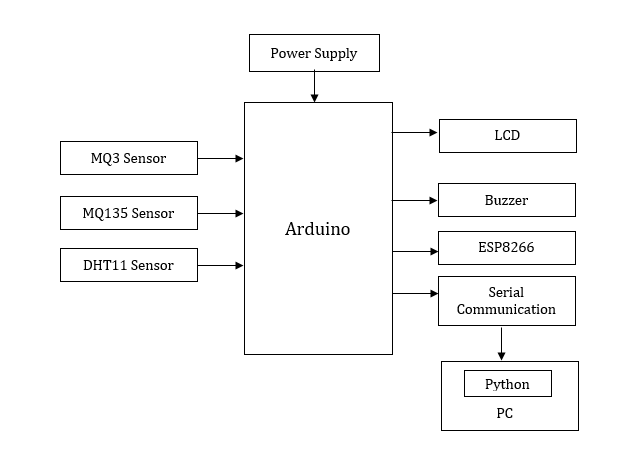Air Quality Monitor System Using IOT And Machine Learning
Objective
The main objective of this project is to create an air quality monitoring system using IoT and machine learning, allowing real-time data collection and analysis to provide insights into air quality and potentially forecast pollution levels for improved public health and environmental awareness.
Abstract
Air quality is a critical aspect of environmental health, and the demand for monitoring and data-driven insights has never been greater. This paper introduces an Air Quality Monitor System that leverages the Internet of Things (IoT) and machine learning techniques. The system integrates key components, including an Arduino microcontroller, MQ3 and MQ135 gas and air quality sensors for detecting harmful gases, a DHT11 sensor for environmental conditions, an LCD display for immediate data visualization, an ESP8266 module for cloud-based data upload and Wi-Fi connectivity, a buzzer for alerts, and serial communication with a Python-enabled PC.
The Air Quality Monitor System continuously collects data related to air quality and environmental conditions. Gas sensor MQ3 detect gasses, and a air quality sensor mq135 which measures the quality of air while the DHT11 sensor measures temperature and humidity. The data is presented on LCD display, providing immediate insights to users. Additionally, the system employs the ESP8266 module to upload data to the cloud for remote monitoring and analysis. Machine learning techniques are applied to the collected data to predict air quality trends. In case of hazardous air conditions, a buzzer provides alerts. This innovative system offers a comprehensive solution to air quality monitoring, ensuring that users have access to data and predictive insights. It has applications in environmental protection, public health, and urban planning. Further research and testing are recommended to refine machine learning models and validate its performance in various environmental contexts.
Keywords: Arduino UNO, Air quality monitoring, Machine learning, Sensors, Serial Communication
NOTE: Without the concern of our team, please don't submit to the college. This Abstract varies based on student requirements.
Block Diagram

Specifications
Hardware components:
- Arduino UNO
- ESP8266
- Buzzer
- MQ3 Sensor
- MQ135 Sensor
- DHT11 Sensor
- LCD
- Power supply
- Adaptor
- USB-D cable compatible with arduino programming
- Arduino IDE
- Embedded C
- Python
Learning Outcomes
- Arduino pin diagram and architecture
- How to install Arduino IDE software
- Setting up and installation procedure for Arduino
- Introduction to Arduino IDE
- Basic coding in Arduino IDE
- Working of LCD
- Interface LCD with Arduino
- Working of power supply
- About Project Development Life Cycle:
- Planning and Requirement Gathering (software’s, Tools, Hardware components, etc.,)
- Schematic preparation
- Code development and debugging
- Hardware development and debugging
- Development of the Project and Output testing
- Practical exposure to:
- Hardware and software tools.
- Solution providing for real time problems.
- Working with team/ individual.
- Work on Creative ideas.
- Project development Skills
- Problem analyzing skills
- Problem solving skills
- Creativity and imaginary skills
- Programming skills
- Deployment
- Testing skills
- Debugging skills
- Project presentation skills





 Paper Publishing
Paper Publishing
